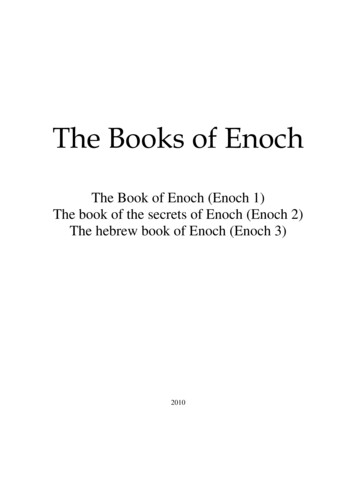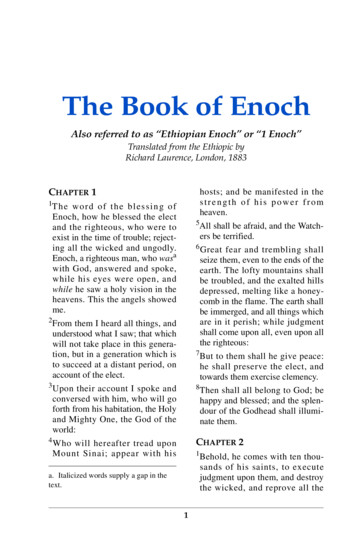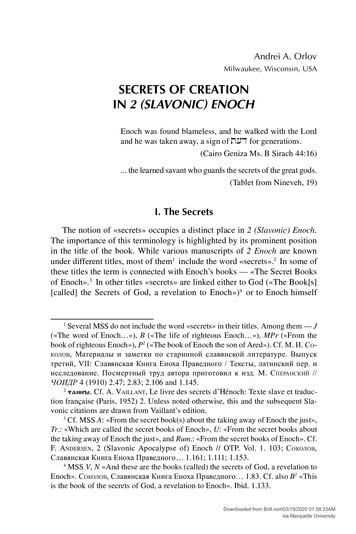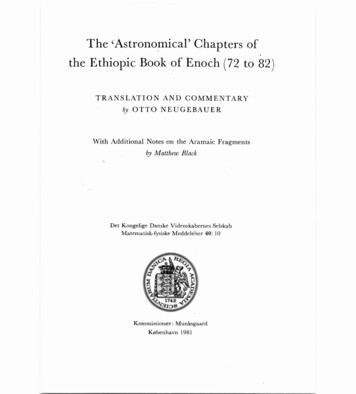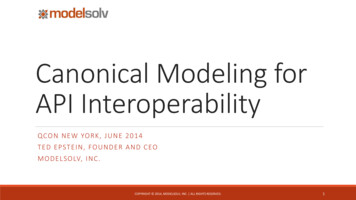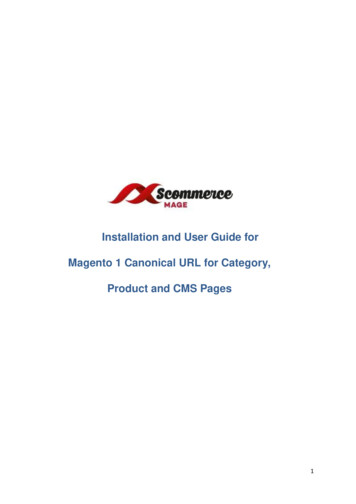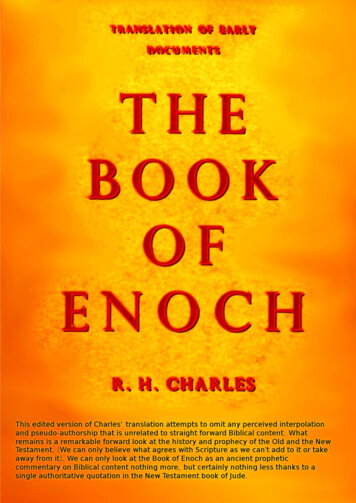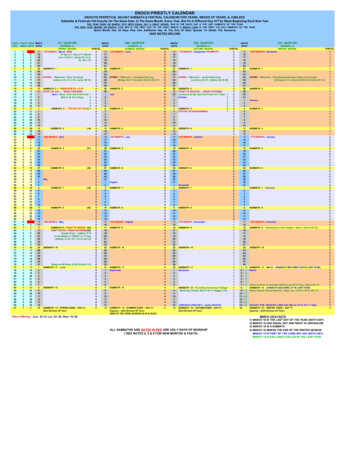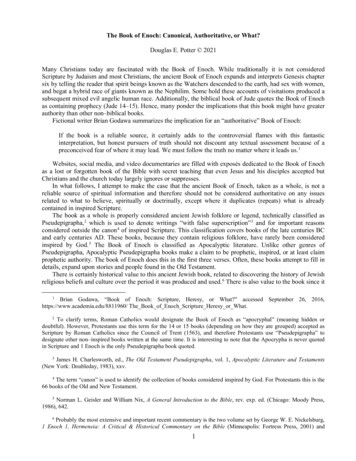
Transcription
The Book of Enoch: Canonical, Authoritative, or What?Douglas E. Potter 2021Many Christians today are fascinated with the Book of Enoch. While traditionally it is not consideredScripture by Judaism and most Christians, the ancient Book of Enoch expands and interprets Genesis chaptersix by telling the reader that spirit beings known as the Watchers descended to the earth, had sex with women,and begat a hybrid race of giants known as the Nephilim. Some hold these accounts of visitations produced asubsequent mixed evil angelic human race. Additionally, the biblical book of Jude quotes the Book of Enochas containing prophecy (Jude 14–15). Hence, many ponder the implications that this book might have greaterauthority than other non–biblical books.Fictional writer Brian Godawa summarizes the implication for an “authoritative” Book of Enoch:If the book is a reliable source, it certainly adds to the controversial flames with this fantasticinterpretation, but honest pursuers of truth should not discount any textual assessment because of apreconceived fear of where it may lead. We must follow the truth no matter where it leads us. 1Websites, social media, and video documentaries are filled with exposés dedicated to the Book of Enochas a lost or forgotten book of the Bible with secret teaching that even Jesus and his disciples accepted butChristians and the church today largely ignores or suppresses.In what follows, I attempt to make the case that the ancient Book of Enoch, taken as a whole, is not areliable source of spiritual information and therefore should not be considered authoritative on any issuesrelated to what to believe, spiritually or doctrinally, except where it duplicates (repeats) what is alreadycontained in inspired Scripture.The book as a whole is properly considered ancient Jewish folklore or legend, technically classified asPseudepigrapha, 2 which is used to denote writings “with false superscription” 3 and for important reasonsconsidered outside the canon 4 of inspired Scripture. This classification covers books of the late centuries BCand early centuries AD. These books, because they contain religious folklore, have rarely been consideredinspired by God. 5 The Book of Enoch is classified as Apocalyptic literature. Unlike other genres ofPseudepigrapha, Apocalyptic Pseudepigrapha books make a claim to be prophetic, inspired, or at least claimprophetic authority. The book of Enoch does this in the first three verses. Often, these books attempt to fill indetails, expand upon stories and people found in the Old Testament.There is certainly historical value to this ancient Jewish book, related to discovering the history of Jewishreligious beliefs and culture over the period it was produced and used. 6 There is also value to the book since itBrian Godawa, “Book of Enoch: Scripture, Heresy, or What?” accessed September 26, 2016,https://www.academia.edu/8811960/ The Book of Enoch Scripture Heresy or What.12To clarify terms, Roman Catholics would designate the Book of Enoch as “apocryphal” (meaning hidden ordoubtful). However, Protestants use this term for the 14 or 15 books (depending on how they are grouped) accepted asScripture by Roman Catholics since the Council of Trent (1563), and therefore Protestants use “Pseudepigrapha” todesignate other non–inspired books written at the same time. It is interesting to note that the Apocrypha is never quotedin Scripture and 1 Enoch is the only Pseudepigrapha book quoted.James H. Charlesworth, ed., The Old Testament Pseudepigrapha, vol. 1, Apocalyptic Literature and Testaments(New York: Doubleday, 1983), xxv.3The term “canon” is used to identify the collection of books considered inspired by God. For Protestants this is the66 books of the Old and New Testament.4Norman L. Geisler and William Nix, A General Introduction to the Bible, rev. exp. ed. (Chicago: Moody Press,1986), 642.56Probably the most extensive and important recent commentary is the two volume set by George W. E. Nickelsburg,1 Enoch 1, Hermeneia: A Critical & Historical Commentary on the Bible (Minneapolis: Fortress Press, 2001) and1
clearly influenced some New Testament authors as well as early church fathers. But in so examining the book,I desire to highlight important features related to the theological principles of canonicity, which clearly showwhy it should not be considered inspired by God and set limitations to its spiritual authoritativeness. In short,I examine the background of the book, theological principles of canonicity applied to the book, and finallyaddress issues and reasons that make taking the Book of Enoch authoritative today problematic.Biblical BackgroundThe man Enoch 7 is first mentioned in Gen. 5:17–24: 8So all the days of Mahalalel were eight hundred and ninety–five years, and he died. Jared lived onehundred and sixty–two years, and became the father of Enoch. Then Jared lived eight hundred yearsafter he became the father of Enoch, and he had other sons and daughters. (Gen. 5:17–19)Genesis continues,So all the days of Jared were nine hundred and sixty–two years, and he died. Enoch lived sixty–fiveyears, and became the father of Methuselah. Then Enoch walked with God three hundred years after hebecame the father of Methuselah, and he had other sons and daughters. So all the days of Enoch werethree hundred and sixty–five years. Enoch walked with God; and he was not, for God took him. (Gen.5:20–24) 9Lamech was the father of Noah, making Methuselah Noah's grandfather, making Enoch his (Noah’s)great–grandfather. Enoch is mentioned in the genealogy of 1 Chron. 1:2–4 and the genealogy of Christ inLuke 3:37, “the son of Methuselah, the son of Enoch, the son of Jared, the son of Mahalaleel, the son ofCainan.” He is also mentioned in Heb. 11:5:By faith Enoch was taken up so that he would not see death; and he was not found because God tookhim up; for he obtained the witness that before his being taken up he was pleasing to God.Finally, Enoch is mentioned by name in Jude (14–15) which follows with the quote from the Book ofEnoch, which we will examine more closely below.It was also about these men that Enoch, in the seventh generation from Adam, prophesied, saying,“Behold, the Lord came with many thousands of His holy ones, to execute judgment upon all, and toconvict all the ungodly of all their ungodly deeds which they have done in an ungodly way, and of allthe harsh things which ungodly sinners have spoken against Him.”The Book of EnochThe Hebrew name Enoch may mean ‘initiated’. He was translated from earth to heaven (Gen. 5:24; cf.Heb. 11:5), and therefore as F. F. Bruce says, “He was envisaged as a suitable recipient of specialGeorge W. E. Nickelsburg and James C. Vanderkam, 1 Enoch 2, Hermeneia: A Critical & Historical Commentary onthe Bible (Minneapolis: Fortress Press, 2011).7There are other uses of the name “Enoch” in the Bible. The son of Cain and a city were named Enoch (Gen. 4:17–8All Scripture quotations are from the New American Standard Bible (NASB).18).It is worth noting that Enoch takes on significant influence within Judaism because all other antediluvian patriarchslived long lives and had their deaths recorded, but not Enoch. He and Elijah are the only ones in the Old Testament whoavoid death and are taken up alive.92
revelations.” 10 One of the central questions the Book of Enoch attempts to explore is what happened to Enochafter he was translated to heaven.The Book of Enoch (or 1 Enoch) is about the size of Isaiah and was written and put together in its presentform between 190 B.C.–900 A.D. It should not be confused with two latter works (2 & 3 Enoch) with asimilar title (see Table 1).OriginalLanguageTitle1 Enoch (Ethiopic Apocalypse)2 Enoch (Slavonic Apocalypse)3 Enoch (Hebrew Apocalypse)Enoch, Book ofEnoch or Words ofAramaic/HebrewEnochThe Book of theSlavonicSecrets of EnochHebrew Enoch orHebrewBook of the PalacesTable 1Date written190 BC–AD 900Late 1st century AD5th—6th century ADThe Book of Enoch was put together over a century. It concerns itself with traditions associated with thenames of Noah and Enoch who received a complex body of divine secrets. It also attempts to explain portionsof Scripture especially the marriage of the angels in Gen. 6:1–4 and the prehistory of the Deluge. It attemptsto continue the prophetic and apocalyptic traditions of the Old Testament as well as explain cosmic mysteries,sun, moon, and stars. It is believed that some parts of it, especially the Noah traditions, short Apocalypse ofTen Weeks, and Treatise on Astronomy circulated independently for a while. 11Author, Place, and LanguageMost scholars seem to agree that the book is a Jerusalem composition by Pharisees, Scribes and/or maybesome parts by Sadducees. The book was also likely written by Jews who viewed the second-temple Judaismas apostate. This is deduced from encrypted statements against the current temple operations in the book.Most scholars also recognize multiple authorship over time. This is especially evident when the secondsection of 1 Enoch (chaps. 37–71) called Parables is compared to chaps. 1–36, which is of a later date.The likely original language is Aramaic with some portions (chaps. 37–71) in Hebrew. 12 The book wasused by two Jewish sects (that we know of). Evidence suggested 1 Enoch was used or influenced theMagharians (200 BC) and Essenes at Qumran, which also preserved the Dead Sea Scrolls (DSS). 13 FirstEnoch shows similarities with the Qumran sect calendars and angelology. Bruce asks and answers thequestion: was 1 Enoch “reckoned canonical by the Qumran community? There is no evidence which wouldjustify the answer ‘Yes’ on the other hand, we do not know enough to return the answer ‘No’.” 14 Indeed, asnoted by George W. E. Nickelsburg, there are important differences between the Qumran community and 1Enoch, such as many other texts attesting to “the notion of covenant and adherence to the Mosaic Torah stoodat the heart of the Israelite self–identification in a way that is strikingly absent in 1 Enoch’s sapiential ethicand eschatology. . . . In their later history, the Qumranites tied their eschatology to the biblical prophets rather10F. F. Bruce, The Canon of Scripture (Downers Grove: InterVarsity Press Academic, 1988), 13, 85.Leonhard Rost, Judaism Outside the Hebrew Canon: An Introduction to the Documents (Nashville: Abingdon,1976), 136.1112Rost, 134–140.David R. Jackson, Enochic Judaism: Three Defining Paradigm Exemplars (New York: T&T Clark International,2004), 8.13Bruce, 39–40. Nickelsburg agrees saying, “To what extent 1 Enoch functioned as authoritative scripture amongJews is uncertain.” 1 Enoch 1, 82.143
than to primordial, pseudonymous Enochic revelation. . . .” 15 Furthermore, 1 Enoch is not found amongmainstream Rabbinic Judaism and therefore was not considered Scripture by them. Hence it would seem, onthis basis alone, it is not at all wise to view it on par with the books of the Old Testament canon.Structure / DivisionsEvidence at Qumran suggests that material was combined in several booklets, and an ancient reader maynot have had access to the entire work. 16 The final author or compiler divided 1 Enoch into five parts (perhapsto reflect the Pentateuch) and since the sixteenth century is divided into 108 chapters including two shortappendices. 17I. The Book of the Watchers (1–36)II. Similitudes (also Parables 37–71)III. Astronomy Book (72–82)IV. Book of Dreams (83–90)V. Epistle of Enoch (91–105)The Birth of Noah (106–107)Another Book by Enoch (108)What follows is a synopsis of some major sections and chapters: Chapters 1–5 is an introduction whichalso describes the coming judgment of the world. Chapters 6–16 concern angelology, the fall of the angelsand announcement of their punishment by Noah and Enoch. Chapters 17–19 and 20–36 contain Enoch’sJourney (two accounts) through the earth, heavens, and underworld. Chapter 37–71 has an introduction (37)and messianology discourse on a future dwelling place of the righteous and ministry of angels, astrologicaland meteorological information (38–44). Chapters 45–57 contains discourses on the Messiah and hisJudgement. Chapters 58–59 concerns judgment of the Son of Man upon men and angels. Chapters 70–71 areEnoch’s entrance into Paradise and his appointment as the Son of Man. Chapters 72–82 deals with astronomyand calendar, sun and moon, intercalary days, stars, cardinal points, phases of the moon (72–80; 82:4b–20),and conclusion of Enoch’s journey (81:1–82:4). Chapters 83–90 is a dream/vision of the coming Deluge (83–84), symbolic imagery from Adam to the coming Messiah (85–90). Chapters 91–105 is an exhortationaddressed to Enoch’s children (93:1–14 and 91:12–17), Apocalypse of Ten Weeks, which covers humanhistory down to the age of salvation beginning with universal judgment. Finally, chapters 106–108 concludesthe book, recounting the birth of Noah accompanied by miracles and the final exhortation by Enoch.18ManuscriptsExtant manuscripts (MSS) display various titles for the book. Some of these include: “Enoch,” “Book ofEnoch” or “Words of Enoch,” and “Ethiopic Apocalypse of Enoch.” The earliest fragments are found inQumran as part of the DSS and include ten Aramaic fragments (1 Enoch 30:1–32:3; 35:1–36:4; 77:3) parts ofthe fifth book and Apocalypse of Ten Weeks. There are no fragments of any Similitudes (also called Parables)(chaps. 37–71). Seven fragments preserve chapters 1–36, 85–90, 97–100. Four fragments contain only the15Nickelsburg, 1 Enoch 1, 78.16James C. VanderKam, “1 Enoch, Enochic Motifs, and Enoch in Early Christian Literature,” in The JewishApocalyptic Heritage in Early Christianity, ed. by James C. VanderKam and William Adler (Minneapolis: FortressPress, 1996), 34.George W. E. Nickelsburg and James C. VanderKam, 1 Enoch: The Hermeneia Translation (Minneapolis:Fortress Press, 2012), 1.1718Rost, 134–140.4
Book of the Luminaries (chaps. 72–82). Nine fragments contain parts of the Book of Giants. 19 All in all, thesefragments contain about 196 verses of a total of 1062 verses or about 1/5th of the full Ethiopic text.The Greek version contains about 28 percent of 1 Enoch preserved in fragmentary texts translated from anAramaic original. The most important is the Chester Beatty Papyrus (Enoch 97:6–107:3), which shows thatthe Greek translation based on Jude’s citation, Latin fathers, and Greek church fathers were in place by theend of the first century.The Ethiopic version dates from the fourth and sixth centuries, but there are 1,000 years to the first extantMSS. It preserves the largest amount of its content and was discovered by James Bruce in Abyssinia, Scottishexplorer in 1769. The Ethiopic church canonized the Book of Enoch, but it was never placed in the Septuagint(LXX), the Greek Translation of the Old Testament. The Ethiopic version dates about 500 AD and wastranslated from Greek, and that was likely translated from an Aramaic original. See Table 2 for a list oflanguages, fragments, and MSS.LanguageAramaicGreekLatin (quotations)MSS or Fragments7 fragments4 fragments9 fragments(Qumran / DSS)Date3rd to early 2ndcentury BC2 fragmentsOxyrhynchus Papyrus4th century ADChester Beatty PapyrusAkhmim(Codex Panopolitanus)4th century AD5–6th centuryADChronography of GeorgeSyncellus9th century ADCodex VaticanusPseudo–CyprianTertullianOther Latin Fathers11th century AD1 Enoch1–36, 85–10772–82Book of Giants77:7–78:1;78:8; 85:10–86:2; 87:1–397:6–107:319:3;1:1–32:6a6:1–9:4; 8:4–10:14; 15:8–16:189:42–499th century AD106:1–18; 1:9;99:6–7CopticCoptic fragmentApocalypse of Weeks6th century ADParts of 93:3–8SyriacExcerpt from Book of theWatchers12th century AD6:1–9Ethiopic Version49 MSS of 1 Enoch16–18th centuryAD1–108Table 2 20The geographic acceptance or rejection of 1 Enoch cannot be established with certainty. Only awarenessof 1 Enoch can be established based on extant fragments and MSS. Parts of 1 Enoch existed in Palestine,Syria, Asia Minor, Athens, Rome, and Carthage. Probably the most popular acceptance was among hereticalsects and diminishing acceptance among Christians in Egypt.The first English translation was made by Richard Laurence in 1821, followed by his published Ethiopictext in 1838. Early English translations were primarily based on Ethiopic sixteenth–century MSS. Robert. H.Charles’s English translation is probably the most widely known and used (1893). Ephraim Issac provides atranslation as a part of the published collection of The Old Testament Pseudepigrapha (1983). However, hisThe Book of Giants may have been a part of Enochic writings and expands upon 1 Enoch 6–16; however, itsrelation to manuscripts (codicology) is uncertain.20Compiled from Nickelsburg, 1 Enoch 1, 9–17.195
translation is based on only one 15th century Ethiopic MSS. R. H. Charles (1906) and Michael Knibb (1978)have published critical texts of the Ethiopic version that incorporate recent fragments.21 Matthew Black madeanother English translation and commentary (1985). However, to date, probably the best critical translationwith a textual apparatus is the two–volume commentary by George W. E. Nickelsburg (2001). 22Date / Chronological DevelopmentDating and constructing a chronological development to 1 Enoch is quite challenging. The followingcompares three attempts that show some overlap and differences. E. Isaac’s work is represented in Table 3: 23Title of Section1. Apocalypse of Weeks2. Fragments of Enochic Visions3. Fragments of the Book of Noah4. Independent Fragment5. Dream Visions6. Book of Heavenly Luminaries7. Similitudes8. Later additions to Dream Visions9. Introductory ChaptersChapters: verses91:12–17; 93:1–1012–166–11; 106f. cf, 24:7–55:2; 60;65–69:2510583–9072–8237–7191:1–11; 18, 19; 92; 91–1041–5Table 3Suggested Period/DateEarly pre–MaccabeanEarly pre–MaccabeanLate pre–Maccabean? pre–Maccabeanc. 165–161 B.C.c. 110 B.C.c. 105–64 B.C.c. 105–104 B.C.Late pre–ChristianLeonhard Rost provides a similar chronology as follows: The Book of Noah (6–11; 39:1–2a; 54:7–55:2;60; 65:1–69:25 and 106–107) is likely from Palestine (Jerusalem) around 190 BC, which is beforeMaccabees. The Apocalypse of Ten Weeks (93; 91:12–17) 170 BC or prior to the Maccabean period. TheSimilitudes or Parables chapters 37–71 100 BC. Chapters 72–82, Astronomical treatise and chapters 94–105Enoch’s Exhortations, beginning (chapters 1–5) and conclusion (chapter 108) and redactional aspects datefrom the first century. In short, his chronology displays in Table 4. 24 Note that Isaac and Rost agree thatexcept for chapters 1–5, the majority of the book was in existence well before the ministry of Christ (AD 29–33).Date190 BC170 BC130 BC100 BC50 BCSectionBook of NoahApocalypse of Weeks, JourneysectionsAstronomical sections, ning and end of EthiopicEnochTable 421R. H. Charles, The Ethiopic Version of The Book of Enoch (Oxford: Clarendon Press, 1906). Michael A. Knibb,The Ethiopic Book of Enoch: A New Edition in Light of the Aramaic Dead Sea Fragments (Oxford: Clarendon, 1978).22Nickelsburg, 1 Enoch 1 and 1 Enoch 2. See also his English translation (2012).E. Isaac, “1 (Ethiopic Apocalypse of) Enoch (Second Century B.C.–First Century A.D,” in The Old TestamentPseudepigrapha vol. 1, Apocalyptic Literature and Testaments (New York: Doubleday, 1983).2324Adapted from Rost, 134–140, 199–201.6
Finally, James VanderKam, suggests a broader chronological order that does place the Similitudes(Parables) within the 1st century AD (Table 5). 25The Astronomical Book (1 Enoch 72–82)The Book of the Watchers (1 Enoch 1–36)The Epistle of Enoch (1 Enoch 91–108)The Book of Dreams (1 Enoch 93–90)The Book of Parables (1 Enoch 37–71)Table 5Uses of 1 Enoch3rd century BC3rd century BC2nd century BC2nd century BC1st century ADNew TestamentSome attempt to show 1 Enoch’s influence on the New Testament by displaying long lists of supposedlanguage/thought parallels or similar/same words and phrases being used. 26 However, just finding parallels inlanguage does not necessarily establish dependence as a source. This is because people in the same culturalcontext, in the same period with similar influences and education will tend to use the same words and phrasesregardless of whether they are writing about the same or even different topics. Writing on the issue of paganreligious influences in the New Testament, Ronald Nash points this out:Suppose a biblical writer, in order to communicate his distinctive message more effectively, adoptscertain pagan language used by his audience. Is that accommodation? Imagine that a New Testamentauthor refers to pagan ideas in order to contrast more sharply his own distinctive Christian beliefs. Isthat accommodation? I judge not. . . . we find that it is not the mere presence of genuine parallels inthought and language that proves dependence and accommodation. We must analyze the biblicalwriting to see if the author’s Christian beliefs have been shaped by, or derived from, the non–Christianparallel. 27In other words, sometimes a more vigorous historical connection or literary analysis needs to be made tojustify dependence. Some have noted how very little influence and dependence there is with such books asRevelation, given they share the same genre of Apocalyptic literature. 28 Still, others point to widespreadinfluence with the use of “Son of Man.” 29 While by no means exhaustive, the Nestle–Aland Greek NewTestament in its list of allusions and verbal parallels lists 14 from the New Testament (Table 6). 30Enoch1.225Biblical AllusionParallel1 Peter 1:12orVerbalVanderKam, “1 Enoch, Enochic Motifs, and Enoch in Early Christian Literature,” 33.Joseph B. Lumpkin, The Books of Enoch (Blountsville, AL: Fifth Estate, 2011), 11–14; and Michael S. Heiser,Reversing Hermon: Enoch, The Watchers and The Forgotten Mission of Jesus Christ (Crane, MO: Defender, 2017),204–221.2627Ronald Nash, The Gospel and the Greeks (n.p.: Probe Books, 1992), 121.Roger Beckwith, The Old Testament Canon of the New Testament Church (Grand Rapids: Eerdmans, 1985), 401.For examples of its similarities in Revelation see Ben C. Blackwell et al., eds., Reading Revelation in Context (GrandRapids: Zondervan, 2019).2829Nickelsburg, 1 Enoch 1, 83.30Adapted from Barbara and Kurt Alan, et al., eds. The Greek New Testament (United Bible Society, 1993), 900.7
1.99.414.2225.2246.351.260.863.1069.2770.1–4Jude 14–15 (only quotation)Rev. 15:3Rev. 17:14Rev. 19:16Rev. 5:11Rev. 15:3Col 2:3Luke 21:28Jude 14Luke 16:9John 5:22Heb 11:5Table 6The clearest traceable and significant influence of the Book of Enoch on the New Testament is 1 Peter,Jude, and Revelation. 31 Three verses from 1 Enoch show parallel in the book of Revelation, which is the mostsimilar in genre. But there is far greater literary dependence in the book of Revelation on the Old Testament.There could also be dependence in the New Testament on Rabbinic traditions (see below), which could be acommon source of influence on both the New Testament and the Book of Enoch.Literature Outside the BibleThe Epistle of Barnabas (written in Egypt AD 140) is likely the first work to quote 1 Enoch as“Scripture” (4.3). Other works do show familiarity with it, such as the Apocalypse of Peter. 32 Interestingly,there are some ancient texts that quote 1 Enoch, but these quotations are not in any Enochian MSS extanttoday. These unknown citations appear in a popular Christian work The Testament of the Twelve Patriarchs,which is a collection of deathbed speeches attributed to Jacob’s sons. This may suggest the text was originallyor at some point larger and perhaps had different versions and portions removed or lost.Early Church Use of 1 EnochThe significant church fathers 33 that referred to or cited 1 Enoch are as follows:Justin Martyr (100–165 AD)Tatian (110–172 AD)Athenagoras (176–180 AD)Irenaeus (130–202 AD)Clement of Alexandria (150–215 AD)Bardaisan (154–222 AD)Tertullian (160–220 AD)Pseudo–Clementine LiteratureJulius Africanus (160–240 AD)Zosimus of Panopolis (late 3rd century)31Two popular books attempting to show influence throughout the New Testament include one reflectingevangelical scholarship, Heiser, Reversing Hermon, and another reflecting liberal scholarship, Margaret Barker, The LostProphet: The Book of Enoch and its influence on Christianity (Nashville: Abingdon, 1988).Other works with possible parallels includes 1 Clement (ca. 100) and Gospel of Peter (2nd century). Many see 1Enoch as an influence in other Pseudepigraphal books including Assumption of Moses, Book of Jubilees, Apocalypse ofBaruch, and Fourth Book of Ezra.3233See Table 8 for a comprehensive list and their citations.8
Origen (185–254 AD)Commodian (ca. 250 AD)Cyprian (d. 258)Lactantius (ca. 240–320)Eusebius (263–339 AD)Hilary of Poitiers (300–368 AD)Jerome (347–420 AD)Augustine (354–430 AD)From this list, the only author that gives a clear indication of accepting it as Scripture was Tertullian. Hisreasons include the possible preservation of Enoch’s writings by Noah, or the Holy Spirit renewing it throughinspiration, and the book has a prophecy from the Lord as Jude recognized. His primary purpose is to drawsupport from 1 Enoch that there was an evil connection or influence when women adorned themselves withcosmetics. He also acknowledged that other Christians denied it as part of Scripture. Likewise, some do seeOrigin as implying it is Scripture, but he also acknowledges others who do not agree and may have doubted itin later writings. 34 While 1 Enoch saw use and certainly interpretive value with other church fathers, there areno explicit statements or other arguments that it should be accepted as Scripture. That leaves every otherchurch father’s position on this matter as being either unknown, or as being against it as Scripture. In thefourth century, the Constitutions of the Holy Apostles says, “And among the ancients also some have writtenapocryphal books of Moses, and Enoch, and Adam, and Isaiah, and David, Elijah, and of the three patriarchs,pernicious and repugnant to the truth.” 35 Some church fathers were even inclined to exclude Jude from thecanon because it quoted a work of doubtful prophetic authenticity. 36Roger Beckwith, in his study of the canon, summarizes 1 Enoch’s role over time in early church thinking:But the vogue of this kind of literature in the early church was great, it was also short–lived. EvenClement of Alexandria who uses it so freely, seems to admit that its use is confined to ‘initiates’, andTertullian, in his treatise On Women’s Dress 1.3, has to defend at length his use of 1 Enoch againstthose who, he acknowledges, rejected it as uncanonical and spurious. By the mid third century, Origenis only using this literature with caution. He quotes from it such things as he can approve of, but that isall: he also refers to things there which he does not approve of. . . . in Against Celsus 5.54f. he rebukeshis opponent for imputing to Christians ideas drawn from 1 Enoch, and for not knowing that “in thechurches the books bearing the name of Enoch are not by any means in circulation as divine.” 37As mentioned before only the Ethiopic church canonized the book. Christianity came to Ethiopia in thefourth century. Nickelsburg gives three reasons that may have led to its acceptance: (1) Christianmissionaries, who held the book in high esteem, brought the book to them; (2) its stories fit the Ethiopianview of their world; and (3) Ethiopian Christians lacked the theological counterforces that lead to the book’srejection in other areas of Christendom.38 Beckwith indicates that eventually the church in this region becameisolated from time to time from the rest of the Christian world because of Islamic control that lasted about 600years. After this period, effort was made by Roman Catholics and Protestants following the Reformation toSee Nickelsburg, 1 Enoch 1, 90–92 and VanderKam, “1 Enoch, Enochic Motifs, and Enoch in Early ChristianLiterature,” 54–59.35“Constitutions of the Holy Apostles” (7.16) in Ante–Nicene Fathers, vol. 7, edited by Alexander Roberts(Hendrickson, 2004).3436This was the reason given by Jerome, Lives of Illustrious Men (4). Eusebius notes its gradual wide acceptance anduse in Ecclesiastical History (2.23). Jude is included in the Bodmer Papyrus MSS which dates from the 3rd century, citedby early church father as Scripture, it was listed in the Muratorian Fragment (c. 170 AD), and was recognized ascanonical in the Third Council of Carthage, AD 397.37Beckwith, 397–398.Nickelsburg, 1 Enoch 1, 106–108. He also points out the authority of the book was disputed within the EthiopianChurch.389
correct doctrinal errors and Christological heresies with the Ethiopic church. Part of this included an attemptto correct canonical issues but was ultimately unsuccessful. 39At this point it is worth emphasizing that the Book of Enoch, compiled over 1,000 years, in part or inwhole, was never included in the Hebrew Bible (the Old Testament according to the Masoretic Text), and itwas never included in the Septuagint (LXX), the Jewish Greek translation of the Old Testament. Parts of itwere found in a few New Testament MSS (e.g., Chester Beatty Papyrus) as well as quotes from early churchfathers. However, such inclusion does not necessitate it was widely accepted as Scripture. Only one churchfather shows clear acceptance of it as Scripture (i.e., Tertullian). The fullest manuscripts of the book availabletoday are those preserved in the Ethiopic canon and from the thirteenth century.Canonicity: Theologically ConsideredDefinitions and DistinctionsThe term “canon” (meaning “rule” or “standard”) has come to be used to identify the collection of booksdiscovered to be inspired by God through prophets. Two inciteful verses describe this process from thestandpoint of the human prophet. Peter says, “For no prophecy was ever made by an act of human will, butmen moved by the Holy Spirit spoke from God
Hebrew Enoch or Book of the Palaces Hebrew : 5th—6th century AD . Table 1 . The Book of Enoch was put together over a century. It concerns itself with traditions associated with the names of Noah and Enoch who received a complex body o divif ne secrets. It also attempts to explain portions
